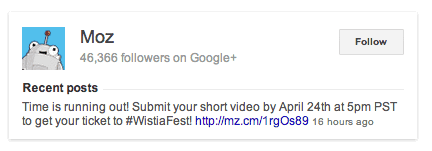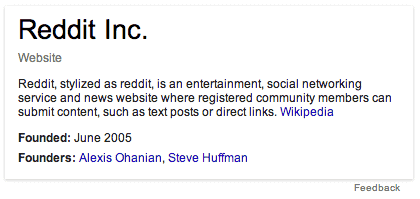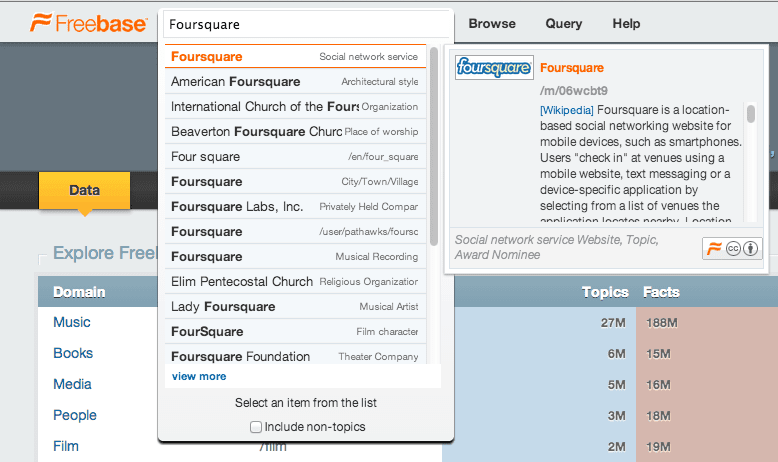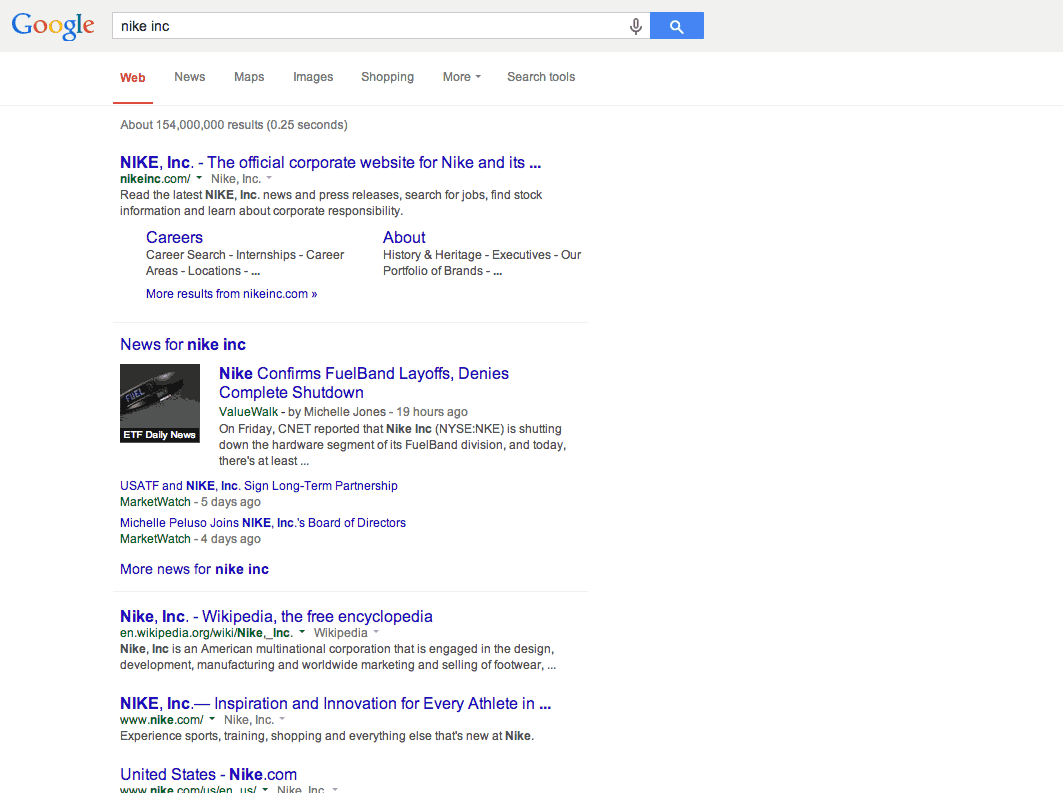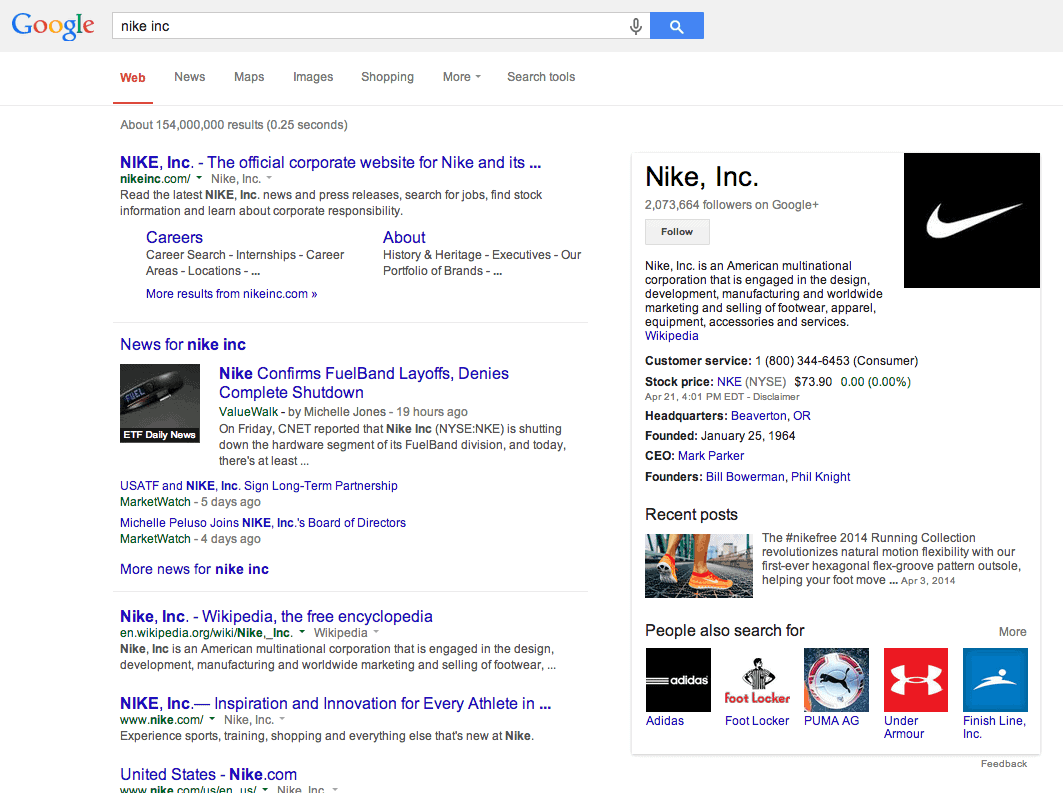Watch as the author gives an in depth presentation of Knowledge Graph Optimization to the Kahena team at a recent Lunch ‘N Learn. The presentation covers Freebase, Google Plus, Wikipedia and much more. After watching – scroll down to read more details to advance your own KGO expertise!
The Video
[youtube=https://www.youtube.com/watch?v=9qKEclHJ4Dc&w=600&h=338&rel=0]
Most of us have seen Google’s Knowledge Graph manifested as the knowledge panel (square to the right of search results that populates with content related to your search query). If you type in a major brand, for example, you’ll get information like stock price, headquarters, founders, # of followers, recent posts and related searches. But did you know you can optimize this same space with information about your brand for related search queries?
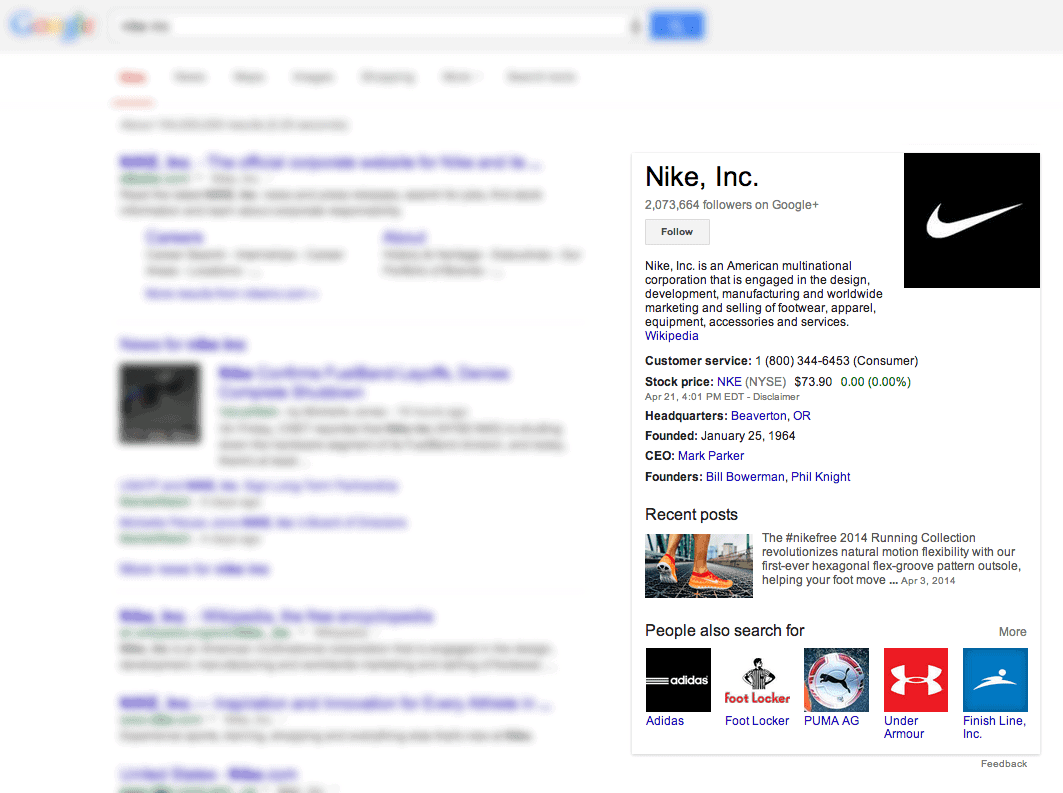
Optimizing Google’s Knowledge Graph can be very beneficial to you and your company (or companies you optimize for). From a branding standpoint, your company will look that much more reputable when their logo shows up next to their website with a link to their Google+ and Wikipedia page.
Furthermore, the Knowledge Graph and knowledge panel is free advertising! If your G+ page is displayed in the knowledge panel, your latest post shared on your G+ account shows as well as a thumbnail of your post’s image. Also, you get between a quarter to half of the page above the fold devoted solely to your company without paying a penny. Pretty sweet if you ask me.
The Four Basic Elements of Knowledge Graph Optimization (KGO)
Here are the four main elements that go into Knowledge Graph Optimization. It is true that the Knowledge Graph pulls from an almost infinite number of sources, these are the four that you can control, optimize and anticipate will directly affect your Knowledge Graph and what displays in your knowledge panel.

Google+
In my opinion, it is imperative for your company to have a Google+ account if you want to have a knowledge panel. Not only does a Google+ account give validity of your company to Google, it also can be used to create a very simple panel of information about your company and get exposure for your social media campaigns. Here’s an example of a Google+ based knowledge panel:
Google+ Account Creation Tips:
These are some basic tips, but not an exhaustive list. For a full list of best practices for creating a Google+ account for a brand, go here.
- Use an email with the domain of the company when creating the account; this verifies the company
- If it’s an international company, do not make a Google+ local account. This will mess up how your knowledge panel displays.
- Keep it active! The latest post from a Google+ account is displayed in the knowledge panel.
- Make sure to put in <a href=”https://plus.google.com/{+PageId}” rel=”publisher” /> so Google+ recognizes your website. Here’s more on that.
Getting the Knowledge Panel to Show Your Google+ Information
Due to their large size, many name brands are able to get a basic knowledge panel (like the one above) automatically. However, if your company is smaller in size, has a Google+ account, yet no knowledge panel, I recommend you utilize Freebase. (More on Freebase, and how to utilize it will be discussed below)
Wikipedia
Wikipedia feeds directly into Freebase, and both of them have been confirmed by Google as sources of information for the Knowledge Graph. If you can, get a Wikipedia article for your company to help better populate your knowledge panel with information. Here’s an example of what a Wikipedia based knowledge panel looks like:
When Reddit’s Wikipedia article was approved, a Freebase topic was immediately created and populated with relevant information by Freebase’s “Wiki Recon Bot”. Google then scraped Freebase and updated the Knowledge Graph and Reddit’s knowledge panel with that information.
Wikipedia Article Writing Tips
Here are some basic tips for writing Wikipedia articles. Again, this is not an exhaustive list and I would highly recommend checking out this article to further help you in the writing process.
- Keep it factual! This is not a space for promotional or marketing material. Write in a non-biased, non-salesy manner. PRO-TIP: If you’re patient, editors are less strict with promotional material after initial publication has been approved. So, at LEAST keep the first try neutral.
- Use applicable Freebase Types and Properties as templates when writing. It will help keep the content more fact-based, and give you ideas to write about.
- Use your competitors’ Wikipedia articles as examples! No need to reinvent the wheel.
Getting Your Wikipedia Article to Show in the Knowledge Panel
If you have a Wikipedia article for your company, but the knowledge panel is not showing, populate your company’s Freebase Topic page with more content. The more connections Freebase, and thus Google, can make, the more likely you are to have a Knowledge Graph with searchable and viewable content.
Schema Markup
Schema markup is a language that helps search engines better understand your site’s content, which search queries best relate to your company, and how to display that information.
Schema can help SERPs display:
- reviews
- prices
- phone numbers
- bread crumbs
- availability of products
and much more!
Schema Markup in Search Results


Here we can see what two different search results look like, one without Schema markup, and one with. When using Schema markup, you loose no character space in your title tags or meta descriptions, yet gain valuable space devoted to information about your site and products. Industry studies show that in most cases, this markup improves click through rate given a static position in the search results.
Schema Markup in the Knowledge Graph
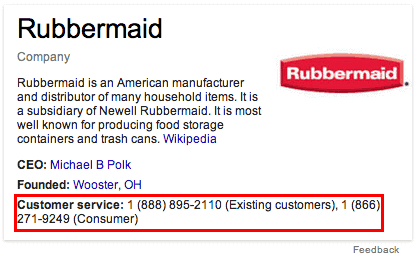
Recently Google has released easy to implement markup for you to display your company’s phone numbers on your knowledge panel. Check it out here. While Rubbermaid (in the example above) didn’t implement Schema markup for this number to show, it is a good example of how phone numbers will manifest themselves in your knowledge panel. For all Schema markup, click here.
Freebase and the Knowledge Graph
The fact of the matter is that Freebase plays a massive role in the Knowledge Graph and Knowledge Graph Optimization, and many companies must utilize it to get Google to show their knowledge panel and other visual elements on the SERPs courtesy of the Knowledge Graph.
Freebase acts as the filing system (in a sense) to the Knowledge Graph. It takes countless sources of relevant, yet unorganized, information from around the web, and organizes and presents it in understandable bits to the Knowledge Graph.
More importantly, Freebase is a crowdsourced system. Users can manually enter and edit information on any Freebase Topic, thus edit, or create information that the Knowledge Graph displays.
Freebase Editing Basics
- Create a Freebase account using one of your previously made Gmail accounts.
- When any Wikipedia article is created, a corresponding Freebase topic page is also created and populated with info.
- If your company doesn’t have a Wikipedia article, you can easily create a Freebase topic page. Just make sure they have a Google+ page so they can at least have a basic knowledge panel.
- If your company has multiple redundant Freebase topics, you can combine topics! Double check first, though, that they are in fact redundant. Freebase can be confusing!
Four Key Terms
The four key words that I have highlighted below are basic Freebase terms. You will see these used on any Topic page, and are important to understand when editing. Check out the graphic below that accompanies the terms to further understand where these terms exist on a Topic page.
Topic: The entity or subject of the page (i.e. Foursquare)
Type: What defines the Topic (i.e. Foursquare is a website, award nominee, software, etc.) You can manually assert types that apply.
Properties: The different elements that make up a Type.
Value: The text entered into the properties section.
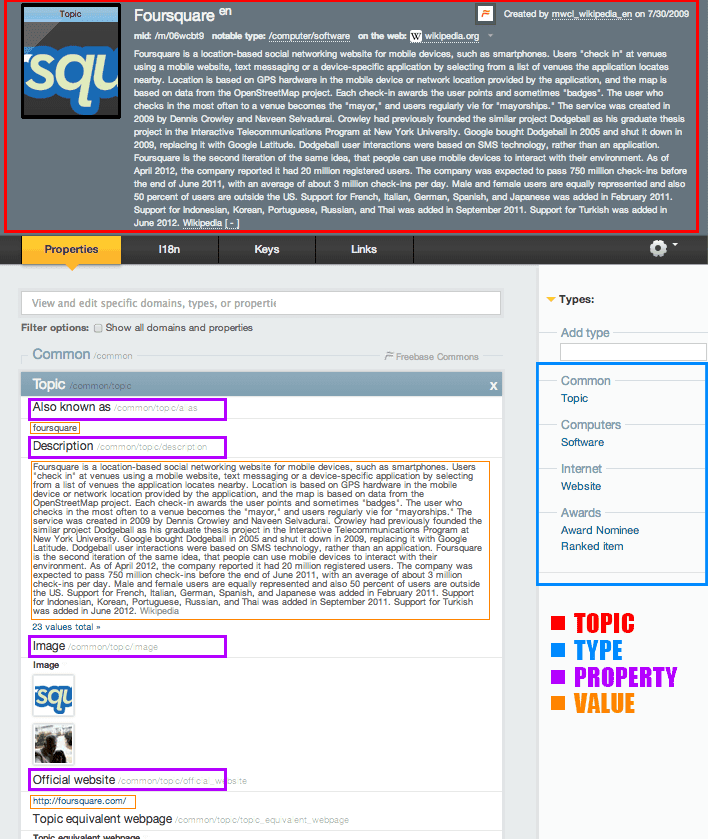
Searching a Topic in Freebase
Go to Freebase.com, find the search bar and type in your company. As you type a list of suggestions will populate. Click your company’s name.
Adding a Topic
If you cannot find your company in the search, this most likely means you do not have a Wikipedia article about your company. Not to worry! You can add your company to the Freebase database.
- Take a look on the front page at the ‘Explore Freebase Data’ section. Select the ‘Domain’ that applies to the topic you’re adding. (Lets assume you’re adding a brand, so click ‘Business’)
- Look through the different Types that come up. If you clicked ‘Business’ on the previous page this next page will say ‘business by Type.’ Select the most applicable Type, or in this scenario, ‘Brand.’
- On this third page, you will see a gear in the mid right side of the page. Click this and select ‘Add Topic.’
- Enter in your brand’s name to the box that appears and click ‘Create.’
Asserting New Types
Asserting new Types helps you to further define your Topic. You can add anything from “computer software,” to “patent assignee,” to “award winner.”
- Once on your company’s Topic page, go over to the Types section and enter in the Type you would like to assert. Look to similar company’s Topic pages on Freebase for ideas on which Types to assert.
- As you enter in the Type you want to assert, a list will pop up and automatically populate with recommendations. Select one.
- Once you select the Type, you will be prompted to ‘Assert this type.’ Click ‘Yes’ if you wish to assert the Type.
- Populate as many Properties as you can in that new Type!
But WHY?
Beyond the fact that it’s really cool being able to edit the Knowledge Graph, there are three great reasons for you to learn Knowledge Graph Optimization.
Branding
Having a chunk of additional information about the company makes a brand look that much more reputable in the eyes of the potential consumer.
Free Ad Space
If done right, at least you get your Google+ account to show, which includes your latest posts and a button to ‘Follow’ your Google+ page. At most you get half of Google’s SERPs devoted solely to your brand. FOR FREE.
Future-Proofing
Google algorithms keep getting smarter and learning what queries relate to which topics by using more intelligent methods.
We don’t know what the next update has in store for us, but one thing’s for sure, the Knowledge Graph and the visual elements which display in the SERPs are here to stay. Get ahead of the curve and get your site connected.
And honestly, which would you prefer?
I would, hands down, pick the option with the knowledge panel. So go! Try out KGO for yourself and see what sort of connections you can create for the Knowledge Graph of your company.

